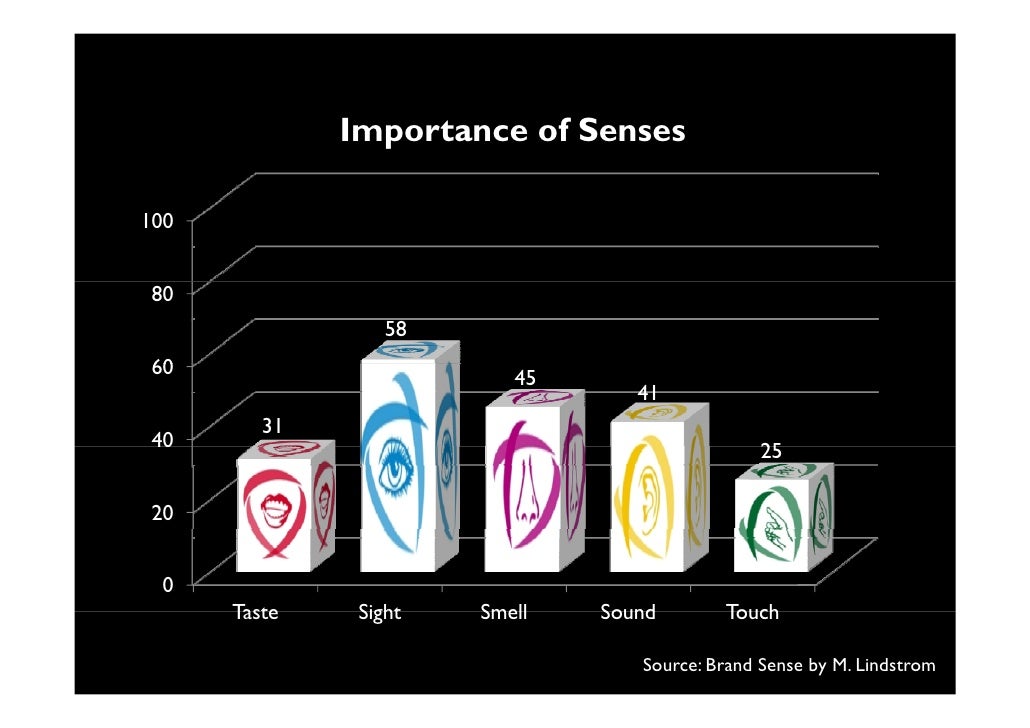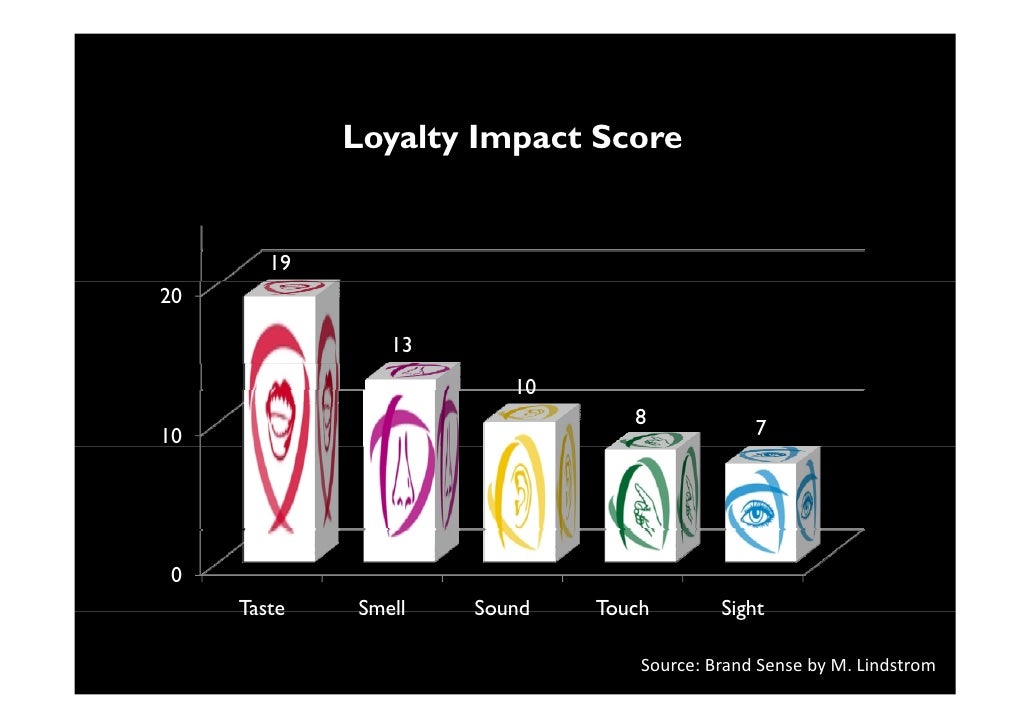LO 1: How do people use their 5 senses in order to receive advertising messages?
LO 2: How to develop a creative message using one or more senses?
How does it differ through different channels?
To watch: A TED video about sensory marketing by Simon Harrop is the CEO of Brand Sense, the global experts in sensory marketing, specialising in sensory retail, space consultancy and product development.
What is sensory marketing?
Sense: Any of the faculties, as sight, hearing, smell, taste, or touch, by which humans and
animals perceive stimuli originating from outside or inside the body.
(Oxford English Dictionary)
Sensory marketing: Marketing techniques that aim to seduce the consumer by using his
senses to influence his feelings and behaviour.
(American Marketing Association)
Several findings have demonstrated that sight is one of the most important senses to be target, but the question is: Do you think the loyalty impact is congruent to the sensory importance? According to Martin Lindstrom the answer is: No.


Sensory marketing has been defined as “marketing that engages the consumers’ senses and affects their perception, judgment and behavior. The purpose of sensory marketing is to generate subconscious triggers that involve consumer’s perceptions of non concrete notions of a product and the personality of the brand (Krishna, 2011) .
Sensory marketing field has the power to create a brand image that is linked to the identity and lifestyle of the customer. The end result of the individual experience or “experience logic” and its value comes from the five human senses, which perceive and interpret the event, either separately or united (Krishna, 2011).
Source: http://adage.com/article/digitalnext/sensory-marketing-frontier-mobile-advertising/296655/
Sensory branding is a marketing approach that has been in use for decades. It empowers brands to forge emotional associations and connections with people through multi-sensory experiences such as sight, sound and touch, which solidify positive feelings, thoughts and opinions about a brand.
Sight is the most stimulated sense in sensory marketing for obvious reasons -- the majority of us can recognize Coca-Cola by its red and white logo. Marketers are also utilizing sound to complement sight, because positive sounds are a great way to inspire lasting memories that tug at people's heartstrings, such as a catchy tune, jingle or song associated with a brand.
Sensory marketing goes beyond just advertising, too. Research has shown that sounds influence people's moods when shopping and can positively impact their purchasing behavior. This is why wine stores play classical music to inspire a quiet, reflective mood that complements the product, while a bar might blast rock music, which has been proven to drive more beer consumption.
According to http://www.samresearch.com/sensory-marketing.html
which gives a general definition of the concept, sensory marketing is an effective tool in gaining sensory consumer insights for a marketing strategy.
It measures and explains emotional consumer decision-making by variability of products,
concepts, packaging, and marketing mix scenarios to ensure long-lasting success.
Sensory marketing is defined as a way of:
• measuring and explaining consumer emotions
• spotting and capitalizing on new market opportunities
• an opportunity to maximize product profitability
• ensuring first and repeat purchase (loyalty)
• ensuring long-lasting product success
It is an effective marketing application which gives to companies a real opportunity to
maximize product profitability.
Some extracts from HBR article The science of sensory marketing
"Much of the new research centers on “embodied cognition”—the idea that without our conscious awareness, our bodily sensations help determine the decisions we make. For example, people who had briefly held a warm beverage were more likely than people who had held a cold one to think that a stranger was friendly; this was demonstrated in an experiment by Lawrence E. Williams, of the University of Colorado at Boulder, and John A. Bargh, of Yale. "
The author of the 2013 book Customer Sense: How the 5 Senses Influence Buying Behavior, Aradhna Krishna got into the field because she was fascinated by certain questions: Why does wine taste better in a wine glass than in a water glass? Why is an ad showing a piece of cake more engaging when the fork is placed to the right of the cake? Why does the smell of cinnamon make a heating pad seem to work better? Krishna realized that the senses amplify one another when they are congruent in some way.
Thinking about sensory effects is an established practice in some consumer industries, such as food, cosmetics, and hospitality. For example, Hershey’s has long been aware that the tactile pleasure people get from unwrapping the foil around a Kiss transforms an ordinary piece of chocolate into a special experience. But many companies are taking their thinking much further. Consider this campaign by Dunkin’ Donuts in South Korea: When a company jingle played on municipal buses, an atomizer released a coffee aroma. The campaign increased visits to Dunkin’ Donuts outlets near bus stops by 16% and sales at those outlets by 29%. Another example is Olay Regenerist thermal facial products, which are engineered to generate heat upon application (although heat isn’t necessary to their functioning) to signal that they are working.
Still, in wide swaths of consumer industries, companies remain focused solely on visual attributes and give little thought to other sensory effects. Product developers and marketers need to change that, Krishna says. Bank executives should make sure that branch offices exude the reassuring, wealth-suggesting aromas of wood and leather. Manufacturers of products with embedded motors should think about those products’ sounds—are they tinny whines or solid, low-pitched hums? Luxury clothing manufacturers doing business online should consider what message is conveyed when goods are shipped in bubble wrap versus high-quality crinkly paper.
Kotler (1973) had already mentioned the need for brands to position them differently that
according to the price or the assortment. He started to explain the influence of the point of
sales physical environment on the behaviour of the customers and gave a definition of the
atmosphere as “the creation of a consumption environment that produces specific emotional effects on the person, like pleasure or excitation that can increase his possibility of buying”.
He considered the creation of this atmosphere as the most important strategic way of
differentiation for retailers.
according to the price or the assortment. He started to explain the influence of the point of
sales physical environment on the behaviour of the customers and gave a definition of the
atmosphere as “the creation of a consumption environment that produces specific emotional effects on the person, like pleasure or excitation that can increase his possibility of buying”.
He considered the creation of this atmosphere as the most important strategic way of
differentiation for retailers.
According to Rieunier (2000), the components of atmosphere are:
- Visual factors: - Colours of the surrounding - Materials - Lights - Layout (space, cleanness)
- Sonorous factors: - Music - Noises
- Olfactory factors - Natural smells - Artificial smells
- Tactile factors - Materials - Temperature
- Gustative factors - Sampling
The following statement sums up the characteristics of each colour and their impact on consumer behaviour (source: Leatrice Eiseman, Impact of colours on consumer purchase behaviour, April 17, 2000. ):
Red
Highest stimulation hue: strong excitation power. Red increases the pulse and heart rate, as it raises blood pressure, and stimulates appetite.
Really popular in restaurants as it increases appetite. However, due to its exciting properties, red is more likely to be used in bars.
Orange
Orange is friendlier than red, but still stimulate appetite and attract attention, especially among kids and teenagers.
Companies like Burger King or Dunkin Donuts use orange as main colour.
Pink
Sweet and appealing. The perfect colour for sweets.
Mainly used by candies producers as Sweet’N Low, and sweet shops.
Yellow
Comforting colour. It can also mean tangy, creamy or delicious connected to aliments.
Popular hue for tea houses or pastry shops.
Green
Meaning of refreshment and nature. Connected to vegetables, it is means healthiness for the consumer.
Green is a delicate colour, as if not used in the right environment it is not appealing but can be repelling.
Blue
Associated with sea and sky calmness, suggest trust and serenity.
As blue icy hues refer to purity and coolness, this is the ideal colour for products like bottled water.
White
Sign of purity, cleanness and coolness. White is the basic colour, as it brings out everything else.
In a restaurant, white is used everywhere the customer expects for cleanness (plates, kitchen…)
Black
On a packaging, black is symbol of top-of range, quality and sobriety.
As it is the darkest colour, black is exclusively used to create a very specific environment.
The light is also a major component of the environment. According to Rieunier (2002), the
differences come from the light source and its intensity: natural light, or softened artificial
one, will increase the well-being sensation and the time spent in a point of sale. On the other
hand, artificial and intense lights will increase customers’ dynamism.
In
Ei kommentteja:
Lähetä kommentti